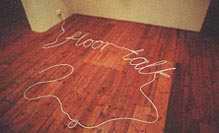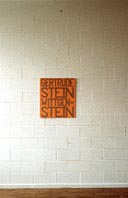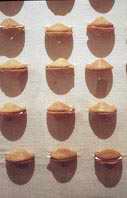 |
i want to take it apart& put it back together again an other
way: d.j. on the mix with zap phut kunst, a ramshakle monument (with
fatty fleshy bits) among c lean s lick theoretical texts. think of
this as a guide to the cathedral & its many interesting grottoes.
space is such a difficult thing to define, it seems to extend from
the mind. if only we could sculpt each breath (it would make your words
go all tinguely every time you said moore). what about an archy text?
the cathedral, the cathedral is useless. if only we could commune.
in the cathedral. i bet you'd like me to write about all my unchained
impulses. you like to watch don't you? (if it's a little dark i'll
lend you my torch)
-D.J. Huppatz, from Zap Phut Knust, insert into Art+Text 1996
 |
Stephen O'Connell
Untitled
(1997) |
What it is
Textbase is an excavation of the space between visual art and writing involving
a loose affiliation of writers from various backgrounds. The project includes
exhibitions by writers and collaborative projects between artists and writers
aiming to free writing from the constraints traditionally associated with art
writing and to establish the practice of writing as one on par with the practice
of visual art. Textbase was and is generated by a dialogue between writers and
artists about the issues of writing's role and function in the visual art context-exhibition
catalogue, review, historical essay, theoretical essay, publications.
Textbase comprises a group of writers who have varying degrees of involvement
with 1st Floor gallery in Melbourne. 1st Floor was founded in 1994 by David Rosetzky
as an independant space for contemporary art. One aim of the gallery was to encourage
collaboration between artists and writers. The possibility of collaboration between
writers and artists was part of the appeal of 1st Floor to the writers who became
involved. The gallery presented the possibility of a space where writing was
valued beyond its usual function within the artworld of justifing, documenting
and contextualising the artwork. The initial idea was to have each exhibition
at the gallery accompanied by a number of short texts, published as a catalogue.
These texts were written by professional writers, friends and relatives of the
artists. The writers at 1st Floor attempted to adopt a position contingent to
that of the artwork, emphasising the subjectivity of the writer and the catalogue
essay as a creative form with the artwork as a point of reference.
A traditional catalogue essay will present the contemporary artwork as the endpoint
of a historical development. For the writers who become involved with 1st Floor
this function of justification and verification was the main point of contention.
Also at stake was the notion that writing functions within the artworld as a
mechanism of closure, forcing completion on a process that most writers and artists
involved with 1st Floor see as open-ended. Furthermore, the writers felt that
art writing always happened after the creative processes of the artist were completed,
adopting a position of transcendence and objectivity in relation to a finished
work.
The 1st Floor catalogues achieved their aim of positing more than one view of
the artworks, and subsequently encouraging critical engagement of the viewer.
But the writers involved with 1st Floor found that this approach neither furthered
nor elaborated the writers' position within the artworld. Central to the writers'
involvement with 1st Floor was the idea that their role in the gallery could
be an active and creative one rather than one which merely reinforces the power
dynamic implicit in institutionalised forms of art writing.
The idea of Textbase came about as a means to establish more collaborative interactions
between artists and writers. A writer-initiated project, Collusions (Nov.
1995), had the explicit intent of encouraging intensive collaborations between
artists and writers and to blur the distinction between the separate activities.
Following this, Textbase was established as a focus for textual activities within
the artworld. EXTRA TEXTA, an exhibition by writers for the 1996 Next Wave Festival,
was the first official Textbase event. This exhibition featured text-based works
employing the strategies of contemporary art. Pieces focused on the materiality
of text, the possibility of intervention within the institutional structures
such as the gallery or the journal, and the extension of philosophical and poetic
practise into unfamiliar territory. A work such as Nicole Tomlinson's Untitled,
consisting of layers of transparences of fragmented text over a lightbox, explored
interpretation as a practice akin to that of archaeology; whilst Andrew McQualter's
painting Word Piece explores a tenuous poetic connection between two writers
for whom langauge was a primary focus. Following EXTRA TEXTA was a series of
solo exhibitions by writers in the small gallery @ 1st Floor: Benjamin Brady,
D.J Huppatz, Nicole Tomlinson, Julian Savage and Stephen O'Connell. Textbase
projects have taken place in different locations including group exhibitions
at Stripp (Melbourne) and 200 Gertrude St. (Melbourne).
  |
|
left to right:
Benjamin Brady
and yet (detail)
(1996)
Andrew McQualter
Word Piece
(1996)
|
What Textbase Does
Art has never stood alone. Within a captialist market economy, where
novelty and innovation equal value, institutions rely on writing to maintain
the aura
and authenticity of an artwork in order to justify their existence. The supposed
autonomy of the art work is backed up, paradoxically, with a full bookshop and
souvenir stand. Within the institution, writing functions to situate the contemporary
art work at the endpoint of art history as a static object rather than as a dynamic
force. Art and writing are locked into the conceptual missionary position whereby
the creative potential of each practise is constrained by the limits of this
binary opposition.
In discussing the function of Textbase within the contemporary artworld it is
perhaps useful to identify two distinct strains of activity. Firstly, Textbase
exhibitions, and secondly, the writing of Textbase contributors which extends
outside the sphere of Textbase (and outside the realm of the artworld). These
two strains are in a sense inseperable as each activity informs the other but
both merge when considered as a combination of both critical and creative practice.
Textbase realises text itself as a creative action as much as contemporary art,
using the ideas explored in texts as a part of the inspiration behind procedures
and making.
Textbase proposes a parasitic association between the writer and the art world
in which both writer and artist exploit what they find useful in the practice
and history of the other. In freeing the artwork and the text from the need to
speak directly about the other, Textbase questions and disrupts this relationship
between the visual arts and the practise of writing. Through its exhibitions
and activities and through its members' contributions to journals, exhibition
catalogues and forums, Textbase is realising art writing as a creative action.
While Textbase exhibitions are open to any kind of practice, writers have chosen
to focus on aspects of visual art where textual theories come into play. These
have included Nicole Tomlinson's combination of personal narrative with investigations
into the archaeology of criticism; Stephen O'Connell's explorations of theories
of thought and interpretation as energy flows; and D.J. Huppatz's use of interpolation
to create an artistic persona. Other Textbase participants have mapped out spaces
where the visual and textual collide such as Benjamin Brady's hypertext arrangement
and Julian Savage's textual work using film and video.
All members of the Textbase project are also practicing writers within the artworld.
The procedural method of writing explored within the catalogues for 1st Floor
has been extended into writing's practical functions such as journalism, catalogue
essays and writing within the academy. The practice of writing at 1st Floor was
informed by contemporary European philosophy, psychoanalytic theory and feminism
and reflected the teaching of local academics such as Elizabeth Grosz and Kevin
Hart, as well as avant garde practices in contemporary literature and film. The
visual artists at 1st Floor have gained in practical terms from their intimacy
with writers attempting to put theory into practice. The writers have gained
valuable insights into the process and working methods of contemporary visual
artists, knowlege which is invaluable for the comtemporary critic. It seemed
obvious the text could gain from the adoption of the approach of the artist-as
in the use of poetic association, appropriation and an awareness of materiality.
What is important here is the idea of doing philosphy, practicing writing rather
than being at the service of forces of capture and control. Traditionally art
writing has prescribed the nature and character of the aesthetic experience as
required by the structures of the institution or of the academy. Rather than
writing as information, the writers involved with Textbase employ language as
seduction, poetry and provocation. This dynamic is played out in recent catalogue
essays by Stephen O'Connell, Andrew McQualter, Sarah Tutton and Tessa Dwyer,
and in the fictocritical mode of D.J Huppatz's articles and reviews.2
Textbase produces work that issues from writing that assumes an open status like
the artwork, works that are the materiality of ideas rather ideas issuing from
materials. Textbase redefines the gallery as a possible site of intersection
between theory/philosphy, poetry, film, fiction, criticism and the visual arts.
This is achieved both through the writers' interventions in the gallery as visual
artists and in their capacity as critics, curators and essayists. The writers
participating in Textbase exploit their knowledge of the visual arts and techniques
of contemporary artistic practice to produce works at this point of intersection.
Textbase does not privilege the art work or the text but sees them as interactive
activities. It explores the similarities of approach and the possibility of applying
the methods of one practise to the procedural process of the other.
D.J Huppatz/Andrew McQualter
|
 |

